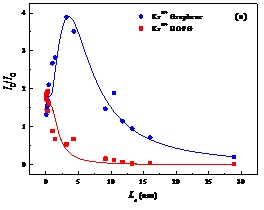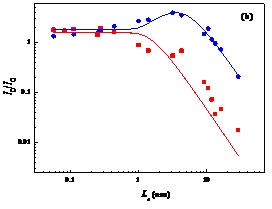Fig. (a) The average distance Ld between the graphite and the graphene ID/IG after irradiation with the highly charged ions Kr19+, and their fitting and comparison with the traces; (b) Kr19+ irradiated graphite and graphite after logarithmic coordinates The variation of ene ID/IG with Ld and its fitting contrast. The Materials Research Center of the Institute of Modern Physics, Chinese Academy of Sciences used fast and heavy ions and highly charged ions to study the effect of single-layer graphene irradiation. Through experimental and theoretical analysis of the radiation damage of graphene and bulk graphite, graphene and bulk were obtained. For the first time, the cause of the difference in radiation damage between the two types of graphite was analyzed. Graphene is the thinnest material known in the world, and it has many magical properties. Its thermal conductivity is 3 times that of pure diamond at room temperature; the ability to store lithium ions is nearly 10 times that of graphite; the speed of electrons in graphene reaches 1/300 of the speed of light, which is 100 times that of silicon. Graphene is expected to replace silicon and become the subject material for a new generation of electronic devices. The study of heavy ion irradiation effects of graphene not only lays a foundation for the application of graphene in a new generation of semiconductor devices, but also regulates the properties of graphene at atomic scale through heavy ion irradiation, broadening the application range of two-dimensional materials. Materials Research Center uses the Lanzhou Heavy Ion Accelerator (HIRFL) to provide energy of 479 MeV for 86 Kr and 250 MeV for 112 Sn fast-charged ions, and the 4 kV MeV 86Kr19+ ion provided by the 320 kV high-charge ion comprehensive research platform for monolayer graphene samples. High directional graphite (HOPG) was irradiated. The data analysis shows that under the same irradiation conditions, the irradiation damage of single-layer graphene and HOPG has obvious differences, so the application of graphene needs to consider the impact of ion irradiation damage. By improving Lucchese's theoretical model, the experimental data of graphene and HOPG were successfully fitted (see the figure below). The results show that the trend of the damage degree (ID/IG) of graphene and HOPG is different with the fluence of the incident ion. In HOPG, there is only an active region, and after the graphene irradiation, in addition to the active region, there is a complete structural damage zone. Regional competition leads to three stages of change in graphene irradiation damage with fluence, with an inflection point in the middle. The research results were published in the engineering magazine Carbon (2016, Vol. 100, Pages 16-26). The above work was funded by the National Natural Science Foundation of China. Yantai Ciso Lubrication Technology Co.,LTD , https://www.cisolubrication.com
